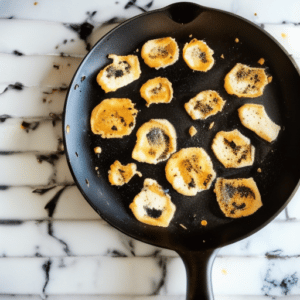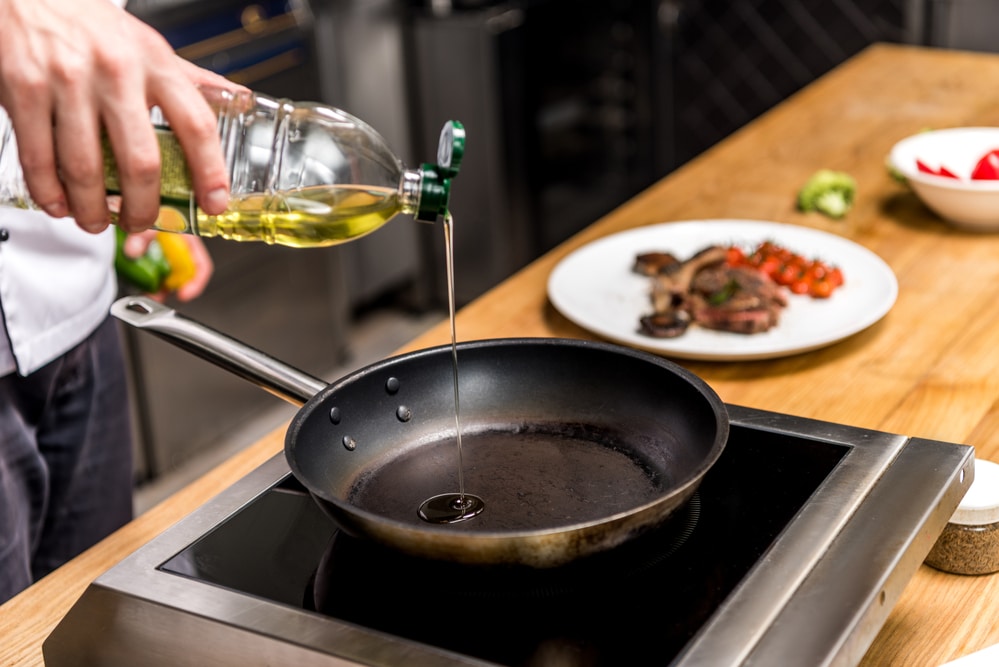It doesn’t matter whether you use cast iron pans or other materials. Season the pan you own for healthier, easier cooking. Pans with non-stick coating do not require a large amount of oil to cook food thoroughly. In today’s article, we’re sharing how to properly season your existing or new pan for easier kitchen work.
How to Season a Frying Pan in Easy Steps
Seasoning a pan means adding a thin layer of oil to fill small pores on the surface and prevent food from sticking. Although non-stick pans prevent a buildup of grease and food in the first place, this non-stick surface can chip and break over time, resulting in food sticking to the pan’s surface again.
Seasoning a pan can prevent uneven spots on the coating, enabling you to continue using it. While for some pans, this is not necessary, for others, such as a cast-iron pan, they cannot be used without. Fortunately, the seasoning process is quite easy, and below is how to season non-stick pans at home:
- Wash your non-stick pan with warm water so that you have a clean surface to begin with.
- Allow the frying pan to dry (naturally or using a soft, clean towel). Once dry, rub your chosen oil onto the bottom of the pan.
- Heat the frying pan with your chosen cooking oil in the pan and rest over medium heat for around two minutes. Some people even choose to place the pan in the oven for 10 minutes, but you’ll need to be extra cautious when touching the handle since it’ll get hot.
- After this period, remove the frying pan from the heat and allow it to cool completely. Then, wipe away any excess oil sitting on the pan with a paper towel, and you will have a seasoned pan ready to use.
Choose Your Oil Wisely
You want a protective layer on your frying pan that prevents food from sticking and won’t easily scratch while you’re stirring ingredients in the pan. Below are some recommended oils to consider, along with their smoking point.
- Canola oil: 240°C
- Peanut oil: 230°C
- Avocado oil: 270°C
- Coconut oil: 170°C
Avoid using olive oil or vegetable oil for seasoning your frying pan, as this type of cooking oil has a low smoke point, resulting in the oil breaking down and beginning to smoke. You should also avoid using butter or other types of oil that have a low smoke point. Instead, consider oils that have a tolerance to high heat, like canola oil or grapeseed oil.
The Benefits of a Seasoned Frying Pan
There are so many reasons to season a frying pan, and below are some of the benefits of seasoning your cookware.
Have a Non-Stick Surface
Seasoning your frying pans means that you create a non-stick surface, preventing food from separating in the pan. Not only does this make stirring more difficult, but it also results in dishes that are unevenly cooked, impacting the overall taste and quality of your food.
Easier Cleanup
Another reason to season your non-stick cookware is to make your life easier during the cleanup process. Nobody wants to spend hours in the kitchen after cooking, spending time scraping and cleaning their frying pans because food has stuck to the bottom. You’ll also encounter less burnt-on food, resulting in less food waste and reduced stress from having to worry about your pans being ruined. If you have invested in a cast iron pan, you want to make sure it lasts!
Non-Toxic Cooking
Finally, another reason to season your frying pan is for safer cooking. Not all non-stick pans provide safe cooking since some non-stick cookware can be coated with chemicals that release toxins into the environment (and your food) once heated.
Signs That You Need to Season a Pan

Not sure if your frying pan needs seasoning? There are some signs to look for that it’s time for seasoning again, such as food sticking to the frying pan’s surface or the base of the pan having a slightly grey hue. You might even notice rust forming on the frying pan’s base.
To keep on top of seasoning your frying pan, you can create a schedule to remind yourself to season your frying pans every couple of months. This is a great habit to get into, rather than waiting until every ingredient sticks to the frying pan to do something about it.
Caring for a Seasoned Frying Pan
Now that you’ve put in all of the effort to season a frying pan with your chosen oil, it’s time to research some ways to take care of your pan so that it lasts longer and the protective coating prevents foods from sticking.
Allow Your Frying Pan to Cool
Before washing or rinsing your frying pan, allow the pan to cool before you submerge it in water. This is because a dramatic temperature change can damage the non-stick coating and cause the pan to warp.
Handwash the Pan
It can be tempting to place the non-stick frying pan in a dishwasher to save time with cleaning up. But, for the best results, handwash the frying pan in hot, soapy water. Use a mild dish soap with natural ingredients rather than a harsh chemical that can damage the frying pan’s surface. Use a soft cloth in circular motions across the surface and rinse thoroughly with clean, warm water. Allow drying thoroughly before placing it back in the kitchen cupboard.
If you need to remove stubborn ingredients engrained on the frying pan, you can use a scratchproof scouring pad that won’t damage the material or scrape off the non-stick coating.
Avoid Harsh Chemicals and Materials
We understand that there’s the temptation to use harsh cleaners and metal scouring pads to remove a buildup of grease and residue. Still, these substances can scratch and damage your frying pan, whether it’s cast iron or enamel.
Use an Alternative Method to Soaking Your Frying Pan
A go-to method for removing food stuck onto a frying pan is allowing it to soak in warm, soapy water. But an alternative method is to pour warm water onto the cookware and add a drop of dishwashing soap onto the pan. Bring the solution to a boil and simmer for several minutes. The boiling action will simulate the dishwashing soap and help to remove any residue without having to use harsh materials and cloths on the bottom of the pan.
Store Your Non-Stick Pan Properly
Finally, it would help if you stored your frying pans properly, with the best way being to hang them up rather than storing them in a cupboard. Ensure that there’s plenty of room between each frying pan to prevent them from chipping or scratching against one another. Alternatively, if you choose to place them in a kitchen cupboard, place a paper towel between them to avoid the bottom of the pans from scratching onto other surfaces, which can damage the coating.
Cooking With Non-Stick Pans
Now that you’re happy with how your pans are seasoned and stored, it’s time to factor in how you cook with your equipment for the best results.
Avoid Using Metal Utensils
It’s important that your stir your food as it cooks in the frying pan, but we recommend avoiding using metal utensils as these can scratch and damage your cookware. For better protection, use nylon, rubber, wooden or silicone utensils that are gentle on the surface.
Avoid High Temperatures
A sure way to encourage food to burn and stick to a frying pan is by cooking at high temperatures. This can also cause a pan to warp as well as cause the non-stick coating to break down. Instead, cook over low to medium heat, which might take slightly longer for your dish to cook but improves the longevity of your cookware.
Preheat Your Pan Before Cooking
This tip applies to all types of pans, not just non-stick frying pans. Preheating a pan will promote even cooking throughout the food. Place your chosen pan over the heat and wait a few minutes for it to heat up before you add food.
Avoid Cooking Sprays With Non-Stick Coatings
Furthermore, avoid using a non-stick spray on a frying pan, as this can damage the pan permanently. These sprays add a sticky layer of fat to the bottom of the pan. If you need to add some fat to the pan when cooking, use cooking oil instead of a spray to keep your pan in tip-top condition.
When Adding Butter
If you need to add butter to the pan, do some before the pan has preheated. This is because adding fat to a heated pan will cause the ingredient to smoke and potentially damage the pan’s surface.
Why You Need to Season Your Cookware
Seasoning your cookware is a sure way to reduce the time spent in the kitchen after cooking. Ensure that you consider the right oil to use and that your pan is clean and dry before you season. After this point, consider putting a paper towel between them in the cupboards to ensure a long life of use in the kitchen. Do you have any tips? Let us know in the comments.

